Space Thread
Previous 1 ... 172 173 174 175 176 177 178 ... 237 Next
DrCaleb @ Fri Jun 12, 2020 7:45 am
$1:
Once Starship Prototypes are Done Exploding, we could see an Orbital Launch this Year

SpaceX has had a lot of ups and downs lately. On Saturday, May 30th, the company made history when their Crew Dragon spacecraft took off from the NASA Kennedy Space Center, carrying two astronauts to space. But just a day before, SpaceX engineers and ground crews watched their fourth Starship prototype (SN4) explode on its testbed during a static fire test, making it the fourth prototype in a row to be lost.
But according to recent news from a SpaceX engineer and executive, as well as an internal email from Elon Musk to SpaceX employees, it is clear that the company is all-in with the Starship prototype and could conduct an orbital flight before the end of the year. An ambitious goal, but you don’t get to be the head of a company that makes reusability a thing and restores domestic launch capability to US soil by being a pessimist!
Not long ago, SpaceX engineers determined the cause of the SN4 explosion, saying that it was the result of a propellant line disconnecting. This led to a major liquid methane leak that then ignited, leading to the spectacular explosion that completely destroyed the SN4. This is similar to what happened during the previous static fire test (on May 19th) where a small fire broke out near the base of SN4 due to a burst methane line.

SpaceX has had a lot of ups and downs lately. On Saturday, May 30th, the company made history when their Crew Dragon spacecraft took off from the NASA Kennedy Space Center, carrying two astronauts to space. But just a day before, SpaceX engineers and ground crews watched their fourth Starship prototype (SN4) explode on its testbed during a static fire test, making it the fourth prototype in a row to be lost.
But according to recent news from a SpaceX engineer and executive, as well as an internal email from Elon Musk to SpaceX employees, it is clear that the company is all-in with the Starship prototype and could conduct an orbital flight before the end of the year. An ambitious goal, but you don’t get to be the head of a company that makes reusability a thing and restores domestic launch capability to US soil by being a pessimist!
Not long ago, SpaceX engineers determined the cause of the SN4 explosion, saying that it was the result of a propellant line disconnecting. This led to a major liquid methane leak that then ignited, leading to the spectacular explosion that completely destroyed the SN4. This is similar to what happened during the previous static fire test (on May 19th) where a small fire broke out near the base of SN4 due to a burst methane line.
https://www.universetoday.com/146472/on ... this-year/
DrCaleb @ Sun Jun 14, 2020 6:57 am
$1:
First Interstellar Parallax Experiment Ever Conducted by NASA’s New Horizons
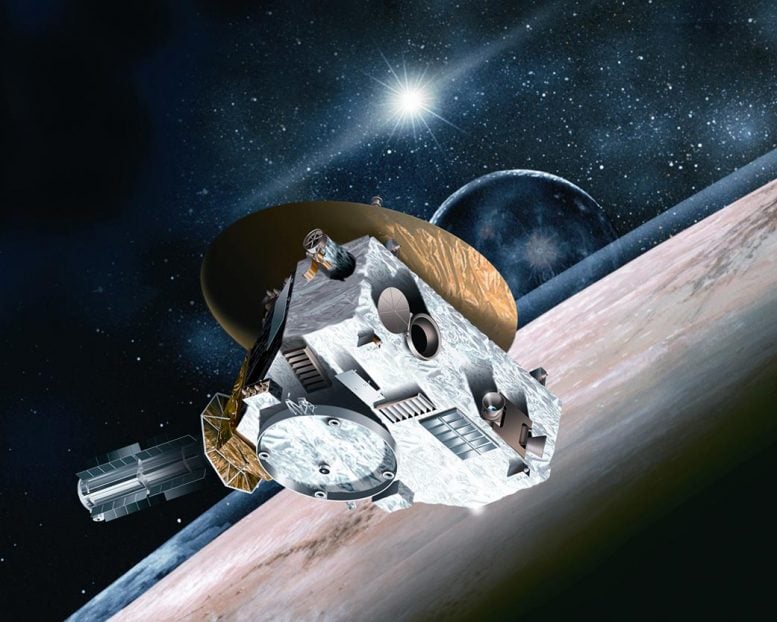
For the first time, a spacecraft has sent back pictures of the sky from so far away that some stars appear to be in different positions than we’d see from Earth.
Proxima Centauri Blinks
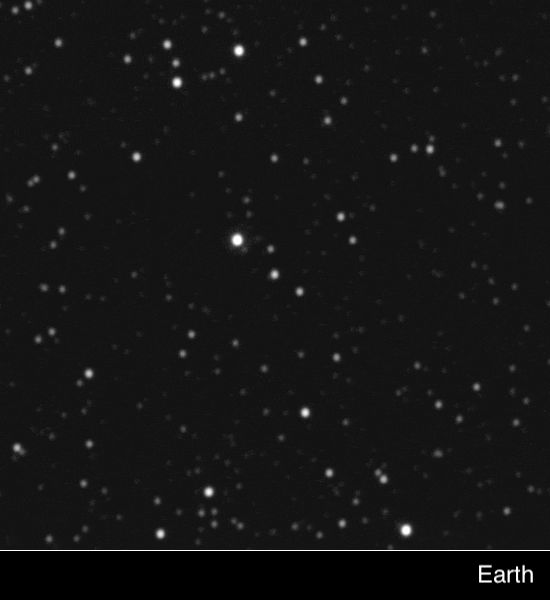
More than four billion miles from home and speeding toward interstellar space, NASA’s New Horizons has traveled so far that it now has a unique view of the nearest stars. “It’s fair to say that New Horizons is looking at an alien sky, unlike what we see from Earth,” said Alan Stern, New Horizons principal investigator from Southwest Research Institute (SwRI) in Boulder, Colorado. “And that has allowed us to do something that had never been accomplished before — to see the nearest stars visibly displaced on the sky from the positions we see them on Earth.”
On April 22-23, the spacecraft turned its long-range telescopic camera to a pair of the “closest” stars, Proxima Centauri and Wolf 359, showing just how they appear in different places than we see from Earth. Scientists have long used this “parallax effect” – how a star appears to shift against its background when seen from different locations — to measure distances to stars.
An easy way to see parallax is to place one finger at arm’s length and watch it jump back and forth when you view it successively with each eye. Similarly, as Earth makes it way around the Sun, the stars shift their positions. But because even the nearest stars are hundreds of thousands of times farther away than the diameter of Earth’s orbit, the parallax shifts are tiny, and can only be measured with precise instrumentation.
Wolf 359 Blinks
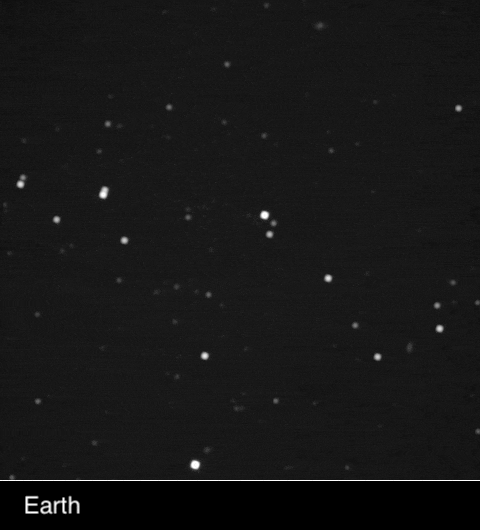
“No human eye can detect these shifts,” Stern said.
But when New Horizons images are paired with pictures of the same stars taken on the same dates by telescopes on Earth, the parallax shift is instantly visible. The combination yields a 3D view of the stars “floating” in front of their background star fields.
“The New Horizons experiment provides the largest parallax baseline ever made — over 4 billion miles — and is the first demonstration of an easily observable stellar parallax,” said Tod Lauer, New Horizons science team member from the National Science Foundation’s National Optical-Infrared Astronomy Research Laboratory who coordinated the parallax demonstration.

For the first time, a spacecraft has sent back pictures of the sky from so far away that some stars appear to be in different positions than we’d see from Earth.
Proxima Centauri Blinks

$1:
This two-frame animation of Proxima Centauri blinks back and forth between New Horizons and Earth images of each star, clearly illustrating the different view of the sky New Horizons has from its deep-space perch. Credit: NASA
More than four billion miles from home and speeding toward interstellar space, NASA’s New Horizons has traveled so far that it now has a unique view of the nearest stars. “It’s fair to say that New Horizons is looking at an alien sky, unlike what we see from Earth,” said Alan Stern, New Horizons principal investigator from Southwest Research Institute (SwRI) in Boulder, Colorado. “And that has allowed us to do something that had never been accomplished before — to see the nearest stars visibly displaced on the sky from the positions we see them on Earth.”
On April 22-23, the spacecraft turned its long-range telescopic camera to a pair of the “closest” stars, Proxima Centauri and Wolf 359, showing just how they appear in different places than we see from Earth. Scientists have long used this “parallax effect” – how a star appears to shift against its background when seen from different locations — to measure distances to stars.
An easy way to see parallax is to place one finger at arm’s length and watch it jump back and forth when you view it successively with each eye. Similarly, as Earth makes it way around the Sun, the stars shift their positions. But because even the nearest stars are hundreds of thousands of times farther away than the diameter of Earth’s orbit, the parallax shifts are tiny, and can only be measured with precise instrumentation.
Wolf 359 Blinks

$1:
This two-frame animation of Wolf 359 blinks back and forth between New Horizons and Earth images of each star, clearly illustrating the different view of the sky New Horizons has from its deep-space perch. Credit: NASA
“No human eye can detect these shifts,” Stern said.
But when New Horizons images are paired with pictures of the same stars taken on the same dates by telescopes on Earth, the parallax shift is instantly visible. The combination yields a 3D view of the stars “floating” in front of their background star fields.
“The New Horizons experiment provides the largest parallax baseline ever made — over 4 billion miles — and is the first demonstration of an easily observable stellar parallax,” said Tod Lauer, New Horizons science team member from the National Science Foundation’s National Optical-Infrared Astronomy Research Laboratory who coordinated the parallax demonstration.
https://scitechdaily.com/first-interste ... -horizons/
DrCaleb @ Mon Jun 15, 2020 10:49 am
$1:
Mars: Green glow detected on the Red Planet
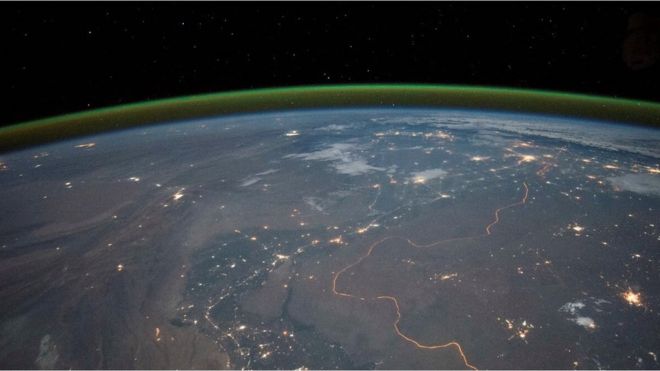
Scientists have identified a green light in the atmosphere of Mars.
A similar glow is sometimes seen by astronauts on the space station when they look to the Earth's limb.
The glow comes from oxygen atoms when they're excited by sunlight.
The phenomenon has long been predicted to occur on other planets, but the Trace Gas Orbiter (TGO) - a joint European-Russian satellite at Mars - is the first to make the observation beyond Earth.
"It's a nice result," said Dr Manish Patel from the UK's Open University.
"You'd never plan a mission to go look for this kind of thing. Today, we have to be very clear about the science we're going to do before we get to Mars. But having got there, we thought, 'well, let's have a look'. And it worked."

$1:
Astronauts see this as a night glow as they look edge-on into the atmosphere
Scientists have identified a green light in the atmosphere of Mars.
A similar glow is sometimes seen by astronauts on the space station when they look to the Earth's limb.
The glow comes from oxygen atoms when they're excited by sunlight.
The phenomenon has long been predicted to occur on other planets, but the Trace Gas Orbiter (TGO) - a joint European-Russian satellite at Mars - is the first to make the observation beyond Earth.
"It's a nice result," said Dr Manish Patel from the UK's Open University.
"You'd never plan a mission to go look for this kind of thing. Today, we have to be very clear about the science we're going to do before we get to Mars. But having got there, we thought, 'well, let's have a look'. And it worked."
https://www.bbc.com/news/science-environment-53057055
DrCaleb @ Mon Jun 15, 2020 11:29 am
$1:
ESA’s Solar Orbiter made its 1st close approach to the sun today
Solar Orbiter swept as close as 50 million miles (77 million km) to our sun’s surface. Now scientists are at work testing the spacecraft’s 10 science instruments, including the 6 telescopes on-board. New images, to be released in mid-July, will be the closest of the sun ever captured.
The European Space Agency (ESA) announced on June 15, 2020 that its Solar Orbiter spacecraft – which sped into space this past February in a dramatic night launch – has made its first close approach to our star. It swept as close to the sun’s surface as about 50 million miles (77 million km), or about half the average distance between the sun and Earth. No images yet! The first ones are expected to be released in July. Meanwhile, the scientists say they will:
Solar Orbiter Project Scientist Daniel Müller commented:
Solar Orbiter swept as close as 50 million miles (77 million km) to our sun’s surface. Now scientists are at work testing the spacecraft’s 10 science instruments, including the 6 telescopes on-board. New images, to be released in mid-July, will be the closest of the sun ever captured.
The European Space Agency (ESA) announced on June 15, 2020 that its Solar Orbiter spacecraft – which sped into space this past February in a dramatic night launch – has made its first close approach to our star. It swept as close to the sun’s surface as about 50 million miles (77 million km), or about half the average distance between the sun and Earth. No images yet! The first ones are expected to be released in July. Meanwhile, the scientists say they will:
$1:
…test the spacecraft’s 10 science instruments, including the six telescopes on-board, which will acquire close-up images of the sun in unison for the first time.
Solar Orbiter Project Scientist Daniel Müller commented:
$1:
We have never taken pictures of the sun from a closer distance than this. There have been higher resolution close-ups, e.g. taken by the four-meter Daniel K. Inouye Solar Telescope in Hawaii earlier this year. But from Earth, with the atmosphere between the telescope and the sun, you can only see a small part of the solar spectrum that you can see from space.
https://earthsky.org/space/esa-solar-or ... ne-15-2020
DrCaleb @ Wed Jun 17, 2020 10:29 am
$1:
Supergiant atmosphere of Antares revealed by radio telescopes
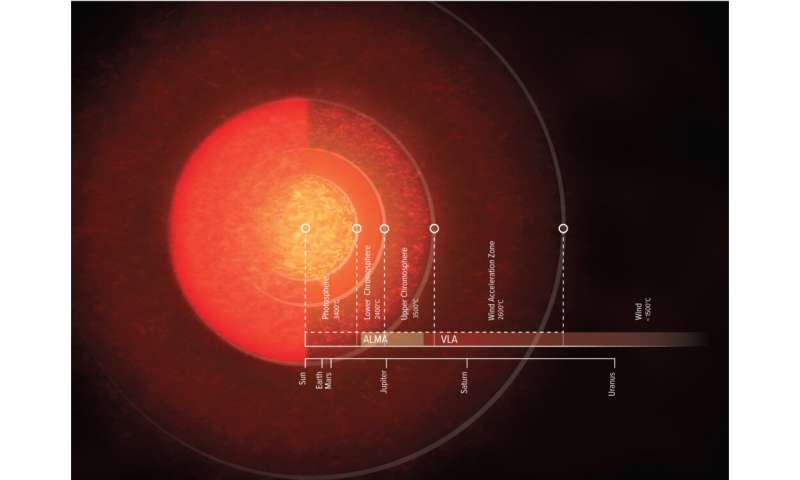
An international team of astronomers has created the most detailed map yet of the atmosphere of the red supergiant star Antares. The unprecedented sensitivity and resolution of both the Atacama Large Millimeter/submillimeter Array (ALMA) and the National Science Foundation's Karl G. Jansky Very Large Array (VLA) revealed the size and temperature of Antares' atmosphere from just above the star's surface, throughout its chromosphere, and all the way out to the wind region.
Red supergiant stars, like Antares and its more well-known cousin Betelgeuse, are huge, relatively cold stars at the end of their lifetime. They are on their way to run out of fuel, collapse, and become supernovae. Through their vast stellar winds, they launch heavy elements into space, thereby playing an important role in providing the essential building blocks for life in the universe. But it is a mystery how these enormous winds are launched. A detailed study of the atmosphere of Antares, the closest supergiant star to Earth, provides a crucial step towards an answer.
The ALMA and VLA map of Antares is the most detailed radio map yet of any star, other than the Sun. ALMA observed Antares close to its surface (its optical photosphere) in shorter wavelengths, and the longer wavelengths observed by the VLA revealed the star's atmosphere further out. As seen in visible light, Antares' diameter is approximately 700 times larger than the Sun. But when ALMA and the VLA revealed its atmosphere in radio light, the supergiant turned out to be even more gigantic.
"The size of a star can vary dramatically depending on what wavelength of light it is observed with," explained Eamon O'Gorman of the Dublin Institute for Advanced Studies in Ireland and lead author of the study published in the June 16 edition of the journal Astronomy & Astrophysics. "The longer wavelengths of the VLA revealed the supergiant's atmosphere out to nearly 12 times the star's radius."

An international team of astronomers has created the most detailed map yet of the atmosphere of the red supergiant star Antares. The unprecedented sensitivity and resolution of both the Atacama Large Millimeter/submillimeter Array (ALMA) and the National Science Foundation's Karl G. Jansky Very Large Array (VLA) revealed the size and temperature of Antares' atmosphere from just above the star's surface, throughout its chromosphere, and all the way out to the wind region.
Red supergiant stars, like Antares and its more well-known cousin Betelgeuse, are huge, relatively cold stars at the end of their lifetime. They are on their way to run out of fuel, collapse, and become supernovae. Through their vast stellar winds, they launch heavy elements into space, thereby playing an important role in providing the essential building blocks for life in the universe. But it is a mystery how these enormous winds are launched. A detailed study of the atmosphere of Antares, the closest supergiant star to Earth, provides a crucial step towards an answer.
The ALMA and VLA map of Antares is the most detailed radio map yet of any star, other than the Sun. ALMA observed Antares close to its surface (its optical photosphere) in shorter wavelengths, and the longer wavelengths observed by the VLA revealed the star's atmosphere further out. As seen in visible light, Antares' diameter is approximately 700 times larger than the Sun. But when ALMA and the VLA revealed its atmosphere in radio light, the supergiant turned out to be even more gigantic.
"The size of a star can vary dramatically depending on what wavelength of light it is observed with," explained Eamon O'Gorman of the Dublin Institute for Advanced Studies in Ireland and lead author of the study published in the June 16 edition of the journal Astronomy & Astrophysics. "The longer wavelengths of the VLA revealed the supergiant's atmosphere out to nearly 12 times the star's radius."
https://phys.org/news/2020-06-supergian ... radio.html
DrCaleb @ Mon Jun 22, 2020 12:13 pm
$1:
Scientists provide new explanation for the strange asymmetry of the moon
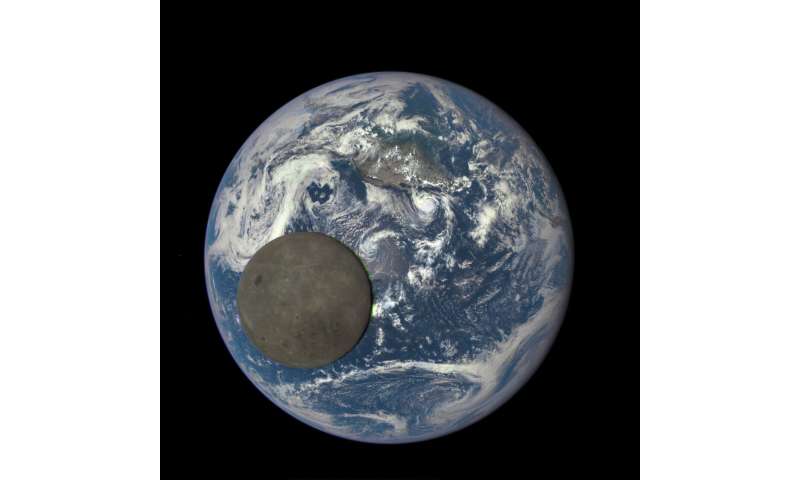
The Earth‐moon system's history remains mysterious. Scientists believe the system formed when a Mars‐sized body collided with the proto‐Earth. Earth ended up being the larger daughter of this collision and retained enough heat to become tectonically active. The moon, being smaller, likely cooled down faster and geologically froze. The apparent early dynamism of the moon challenges this idea.
New data suggests this is because radioactive elements were distributed uniquely after the catastrophic moon‐forming collision. Earth's moon, together with the sun, is a dominant object in the sky and offers many observable features providing evidence about how the planet and the solar system formed. Most planets in the solar system have satellites. For example, Mars has two moons, Jupiter has 79 and Neptune has 14. Some moons are icy, some are rocky, some are still geologically active and some relatively inactive. How planets got their satellites and why they have the properties they do are questions that could shed light on many aspects of the evolution of the early solar system.
The moon is a relatively cold rocky body with a limited amount of water and little tectonic processing. Scientists presently believe the Earth‐moon system formed when a Mars‐sized body dubbed Theia—who in Greek mythology was the mother of Selene, the goddess of the moon—catastrophically collided with the proto‐Earth, causing the components of both bodies to mix.

The Earth‐moon system's history remains mysterious. Scientists believe the system formed when a Mars‐sized body collided with the proto‐Earth. Earth ended up being the larger daughter of this collision and retained enough heat to become tectonically active. The moon, being smaller, likely cooled down faster and geologically froze. The apparent early dynamism of the moon challenges this idea.
New data suggests this is because radioactive elements were distributed uniquely after the catastrophic moon‐forming collision. Earth's moon, together with the sun, is a dominant object in the sky and offers many observable features providing evidence about how the planet and the solar system formed. Most planets in the solar system have satellites. For example, Mars has two moons, Jupiter has 79 and Neptune has 14. Some moons are icy, some are rocky, some are still geologically active and some relatively inactive. How planets got their satellites and why they have the properties they do are questions that could shed light on many aspects of the evolution of the early solar system.
The moon is a relatively cold rocky body with a limited amount of water and little tectonic processing. Scientists presently believe the Earth‐moon system formed when a Mars‐sized body dubbed Theia—who in Greek mythology was the mother of Selene, the goddess of the moon—catastrophically collided with the proto‐Earth, causing the components of both bodies to mix.
https://phys.org/news/2020-06-scientist ... -moon.html
DrCaleb @ Tue Jun 23, 2020 10:06 am
$1:
'Black neutron star' discovery baffles astronomers
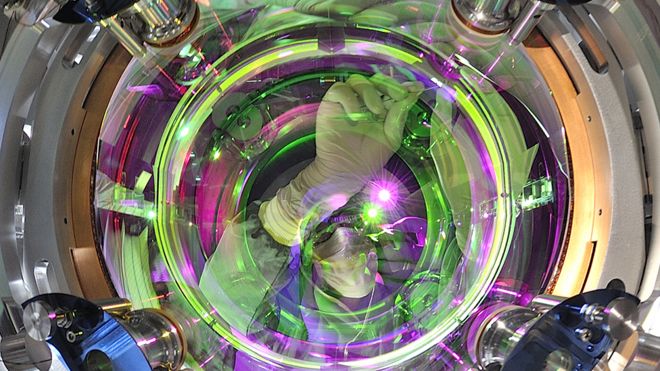
Scientists have discovered an astronomical object that has never been observed before.
It is more massive than collapsed stars, known as "neutron stars", but has less mass than black holes.
Such "black neutron stars" were not thought possible and will mean ideas for how neutron stars and black holes form will need to be rethought.
The discovery was made by an international team using gravitational wave detectors in the US and Italy.
Charlie Hoy, a PhD student from Cardiff University, UK, involved in the study, said the new discovery would transform our understanding.
"We can't rule out any possibilities," he told BBC News. "We don't know what it is and this is why it is so exciting because it really does change our field."
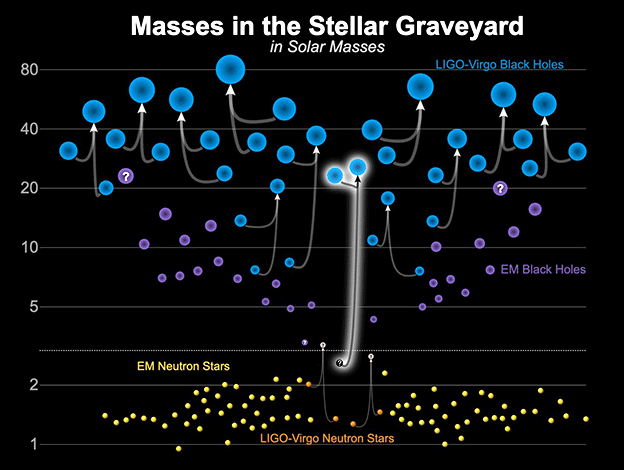
Mr Hoy is part of an international team working for the Ligo-Virgo Scientific Collaboration.
The international group, which has strong UK involvement backed by the Science and Technologies Facilities Council, has laser detectors several kilometres long that are able to detect minute ripples in space-time caused by the collision of massive objects in the Universe.
The collected data can be used to determine the mass of those objects involved.
Last August, the instruments detected the collision of a black hole 23 times the mass of our Sun with an object of 2.6 solar masses.
That makes the lighter object more massive than the heaviest type of dead star, or neutron star, previously observed - of just over two solar masses. But it was also lighter than the lightest black hole previously observed - of around five solar masses.
Astronomers have been searching for such objects in what they've come to call the "mass gap".
Writing in the journal The Astrophysical Journal Letters, the research team believes that of all the possibilities, the object is most likely to be a light black hole, but they are not ruling out any other possibilities.

Scientists have discovered an astronomical object that has never been observed before.
It is more massive than collapsed stars, known as "neutron stars", but has less mass than black holes.
Such "black neutron stars" were not thought possible and will mean ideas for how neutron stars and black holes form will need to be rethought.
The discovery was made by an international team using gravitational wave detectors in the US and Italy.
Charlie Hoy, a PhD student from Cardiff University, UK, involved in the study, said the new discovery would transform our understanding.
"We can't rule out any possibilities," he told BBC News. "We don't know what it is and this is why it is so exciting because it really does change our field."

$1:
This event involved an object more massive than known neutron stars but less massive than known black holes. It existed in what has become known as the "mass gap"
Mr Hoy is part of an international team working for the Ligo-Virgo Scientific Collaboration.
The international group, which has strong UK involvement backed by the Science and Technologies Facilities Council, has laser detectors several kilometres long that are able to detect minute ripples in space-time caused by the collision of massive objects in the Universe.
The collected data can be used to determine the mass of those objects involved.
Last August, the instruments detected the collision of a black hole 23 times the mass of our Sun with an object of 2.6 solar masses.
That makes the lighter object more massive than the heaviest type of dead star, or neutron star, previously observed - of just over two solar masses. But it was also lighter than the lightest black hole previously observed - of around five solar masses.
Astronomers have been searching for such objects in what they've come to call the "mass gap".
Writing in the journal The Astrophysical Journal Letters, the research team believes that of all the possibilities, the object is most likely to be a light black hole, but they are not ruling out any other possibilities.
https://www.bbc.com/news/science-environment-53151106
DrCaleb @ Wed Jun 24, 2020 10:23 am
$1:
Telescope in orbit maps stunning X-ray image of the universe
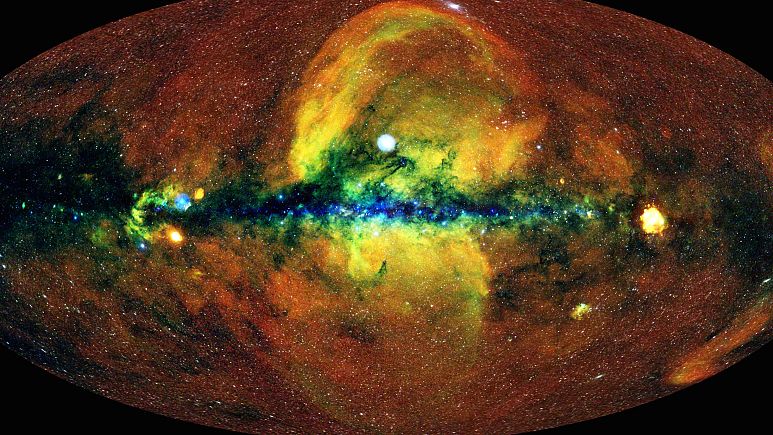
A breathtaking map of the sky has been captured by an X-ray telescope, revealing a universe that looks remarkably different to the one we see with traditional telescopes.
By viewing the universe in X-rays, the so-called "hot and energetic universe" can be seen, detailing objects that emit incredible heat, move at great speed, or are extremely dense.
These include rare phenomena such as merging neutron stars, stars being swallowed by black holes, and less rare but no less impressive - areas of extremely hot gas, where stars are born.
The all-sky image includes one million sources of X-rays, and “completely changes the way we look at the energetic universe”, according to Peter Predehl, the Principal Investigator of the eROSITA telescope at the Max Planck Institute for Extraterrestrial Physics (MPE).
The wealth of data gathered is a huge leap forward from the previous X-ray scans of the sky, with the eROSITA gathering around 10 times more sources than the previous all-sky survey 30 years ago. This is around as many sources as have been discovered by all past X-ray telescopes combined.
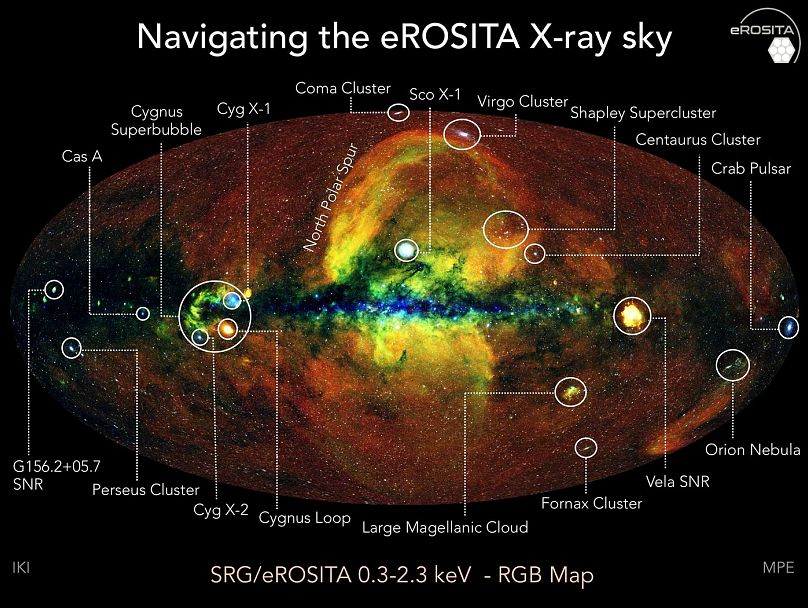

A breathtaking map of the sky has been captured by an X-ray telescope, revealing a universe that looks remarkably different to the one we see with traditional telescopes.
By viewing the universe in X-rays, the so-called "hot and energetic universe" can be seen, detailing objects that emit incredible heat, move at great speed, or are extremely dense.
These include rare phenomena such as merging neutron stars, stars being swallowed by black holes, and less rare but no less impressive - areas of extremely hot gas, where stars are born.
The all-sky image includes one million sources of X-rays, and “completely changes the way we look at the energetic universe”, according to Peter Predehl, the Principal Investigator of the eROSITA telescope at the Max Planck Institute for Extraterrestrial Physics (MPE).
The wealth of data gathered is a huge leap forward from the previous X-ray scans of the sky, with the eROSITA gathering around 10 times more sources than the previous all-sky survey 30 years ago. This is around as many sources as have been discovered by all past X-ray telescopes combined.

https://www.euronews.com/2020/06/23/tel ... e-universe
DrCaleb @ Thu Jun 25, 2020 10:31 am
$1:
Black hole collision may have exploded with light
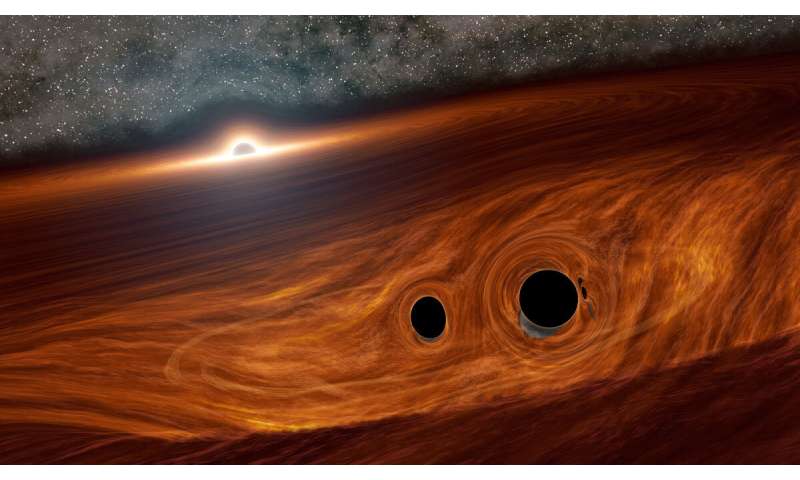
When two black holes spiral around each other and ultimately collide, they send out ripples in space and time called gravitational waves. Because black holes do not give off light, these events are not expected to shine with any light waves, or electromagnetic radiation. Graduate Center, CUNY astrophysicists K. E. Saavik Ford and Barry McKernan have posited ways in which a black hole merger might explode with light. Now, for the first time, astronomers have seen evidence of one of these light-producing scenarios. Their findings are available in the current issues of Physical Review Letters.
A team consisting of scientists from The Graduate Center, CUNY; Caltech's Zwicky Transient Facility (ZTF); Borough of Manhattan Community College (BMCC); and The American Museum of Natural History (AMNH) spotted what appears to be a flare of light from a pair of coalescing black holes. The event (called S190521g) was first identified by the National Science Foundation's (NSF) Laser Interferometer Gravitational-wave Observatory (LIGO) and the European Virgo detector on May 21, 2019. As the black holes merged, jiggling space and time, they sent out gravitational waves. Shortly thereafter, scientists at ZTF—which is located at the Palomar Observatory near San Diego—reviewed their recordings of the same the event and spotted what may be a flare of light coming from the coalescing black holes.
"At the center of most galaxies lurks a supermassive black hole. It's surrounded by a swarm of stars and dead stars, including black holes," said study coauthor Ford, a professor with the Graduate Center, BMCC and AMNH. "These objects swarm like angry bees around the monstrous queen bee at the center. They can briefly find gravitational partners and pair up but usually lose their partners quickly to the mad dance. But in a supermassive black hole's disk, the flowing gas converts the mosh pit of the swarm to a classical minuet, organizing the black holes so they can pair up," she says.
Once the black holes merge, the new, now-larger black hole experiences a kick that sends it off in a random direction, and it plows through the gas in the disk. "It is the reaction of the gas to this speeding bullet that creates a bright flare, visible with telescopes," said co-author McKernan, an astrophysics professor with The Graduate Center, BMCC and AMNH.
"This supermassive black hole was burbling along for years before this more abrupt flare," said the study's lead author Matthew Graham, a research professor of astronomy at Caltech and the project scientist for ZTF. "The flare occurred on the right timescale, and in the right location, to be coincident with the gravitational-wave event. In our study, we conclude that the flare is likely the result of a black hole merger, but we cannot completely rule out other possibilities."

When two black holes spiral around each other and ultimately collide, they send out ripples in space and time called gravitational waves. Because black holes do not give off light, these events are not expected to shine with any light waves, or electromagnetic radiation. Graduate Center, CUNY astrophysicists K. E. Saavik Ford and Barry McKernan have posited ways in which a black hole merger might explode with light. Now, for the first time, astronomers have seen evidence of one of these light-producing scenarios. Their findings are available in the current issues of Physical Review Letters.
A team consisting of scientists from The Graduate Center, CUNY; Caltech's Zwicky Transient Facility (ZTF); Borough of Manhattan Community College (BMCC); and The American Museum of Natural History (AMNH) spotted what appears to be a flare of light from a pair of coalescing black holes. The event (called S190521g) was first identified by the National Science Foundation's (NSF) Laser Interferometer Gravitational-wave Observatory (LIGO) and the European Virgo detector on May 21, 2019. As the black holes merged, jiggling space and time, they sent out gravitational waves. Shortly thereafter, scientists at ZTF—which is located at the Palomar Observatory near San Diego—reviewed their recordings of the same the event and spotted what may be a flare of light coming from the coalescing black holes.
"At the center of most galaxies lurks a supermassive black hole. It's surrounded by a swarm of stars and dead stars, including black holes," said study coauthor Ford, a professor with the Graduate Center, BMCC and AMNH. "These objects swarm like angry bees around the monstrous queen bee at the center. They can briefly find gravitational partners and pair up but usually lose their partners quickly to the mad dance. But in a supermassive black hole's disk, the flowing gas converts the mosh pit of the swarm to a classical minuet, organizing the black holes so they can pair up," she says.
Once the black holes merge, the new, now-larger black hole experiences a kick that sends it off in a random direction, and it plows through the gas in the disk. "It is the reaction of the gas to this speeding bullet that creates a bright flare, visible with telescopes," said co-author McKernan, an astrophysics professor with The Graduate Center, BMCC and AMNH.
"This supermassive black hole was burbling along for years before this more abrupt flare," said the study's lead author Matthew Graham, a research professor of astronomy at Caltech and the project scientist for ZTF. "The flare occurred on the right timescale, and in the right location, to be coincident with the gravitational-wave event. In our study, we conclude that the flare is likely the result of a black hole merger, but we cannot completely rule out other possibilities."
https://phys.org/news/2020-06-black-hole-collision.html
Scape @ Thu Jun 25, 2020 8:21 pm
DrCaleb @ Fri Jun 26, 2020 11:40 am
Intracluster Light in MACS J0416 
https://hubblesite.org/contents/media/i ... 4672-Image
DrCaleb @ Mon Jun 29, 2020 11:23 am
Canadarm3 to support Lunar Gateway space station
DrCaleb @ Mon Jun 29, 2020 11:28 am
$1:
Giant star spots likely cause of Betelgeuse dimming
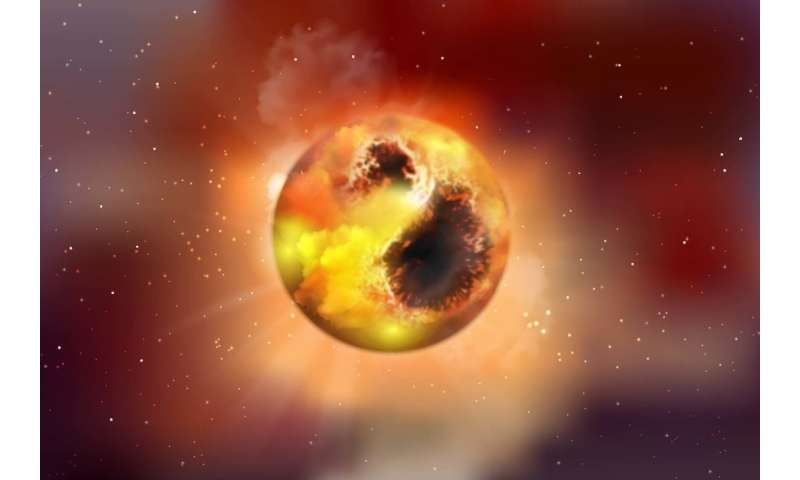
Betelgeuse, the bright star in the constellation of Orion, has been fascinating astronomers in the recent months because of its unusually strong decline in brightness. Scientists have been discussing a number of scenarios trying to explain its behavior. Now a team led by Thavisha Dharmawardena of the Max Planck Institute for Astronomy have shown that most likely unusually large star spots on the surface of Betelgeuse have caused the dimming. Their results rule out the previous conjecture that it was dust, recently ejected by Betelgeuse, which obscured the star.
Red giant stars like Betelgeuse undergo frequent brightness variations. However, the striking drop in Betelgeuse's luminosity to about 40% of its normal value between October 2019 and April 2020 came as a surprise to astronomers. Scientists have developed various scenarios to explain this change in the brightness of the star, which is visible to the naked eye and almost 500 light years away. Some astronomers even speculated about an imminent supernova. An international team of astronomers led by Thavisha Dharmawardena from the Max Planck Institute for Astronomy in Heidelberg have now demonstrated that temperature variations in the photosphere, i.e. the luminous surface of the star, caused the brightness to drop. The most plausible source for such temperature changes are gigantic cool star spots, similar to sunspots, which, however, cover 50 to 70% of the star's surface.

$1:
Red Supergiant: An artist's impression of Betelgeuse. Its surface is covered by large star spots, which reduce its brightness. During their pulsations, such stars regularly release gas into their surroundings, which condenses into dust. Credit: MPIA graphics department
Betelgeuse, the bright star in the constellation of Orion, has been fascinating astronomers in the recent months because of its unusually strong decline in brightness. Scientists have been discussing a number of scenarios trying to explain its behavior. Now a team led by Thavisha Dharmawardena of the Max Planck Institute for Astronomy have shown that most likely unusually large star spots on the surface of Betelgeuse have caused the dimming. Their results rule out the previous conjecture that it was dust, recently ejected by Betelgeuse, which obscured the star.
Red giant stars like Betelgeuse undergo frequent brightness variations. However, the striking drop in Betelgeuse's luminosity to about 40% of its normal value between October 2019 and April 2020 came as a surprise to astronomers. Scientists have developed various scenarios to explain this change in the brightness of the star, which is visible to the naked eye and almost 500 light years away. Some astronomers even speculated about an imminent supernova. An international team of astronomers led by Thavisha Dharmawardena from the Max Planck Institute for Astronomy in Heidelberg have now demonstrated that temperature variations in the photosphere, i.e. the luminous surface of the star, caused the brightness to drop. The most plausible source for such temperature changes are gigantic cool star spots, similar to sunspots, which, however, cover 50 to 70% of the star's surface.
https://phys.org/news/2020-06-giant-sta ... mming.html
DrCaleb @ Tue Jun 30, 2020 11:04 am
$1:
A cosmic mystery: Very Large Telescope captures the disappearance of a massive star
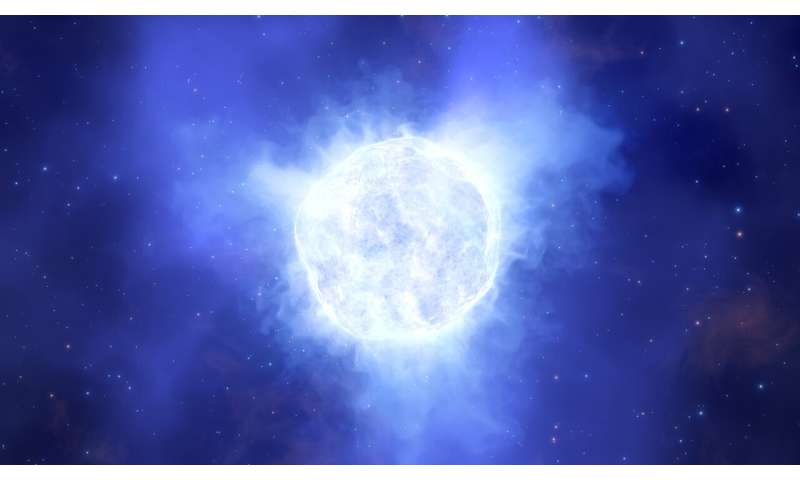
Using the European Southern Observatory's Very Large Telescope (VLT), astronomers have discovered the absence of an unstable massive star in a dwarf galaxy. Scientists think this could indicate that the star became less bright and partially obscured by dust. An alternative explanation is that the star collapsed into a black hole without producing a supernova. "If true," says team leader and Ph.D. student Andrew Allan of Trinity College Dublin, Ireland, "this would be the first direct detection of such a monster star ending its life in this manner."
Between 2001 and 2011, various teams of astronomers studied the mysterious massive star, located in the Kinman Dwarf galaxy, and their observations indicated it was in a late stage of its evolution. Allan and his collaborators in Ireland, Chile and the US wanted to find out more about how very massive stars end their lives, and the object in the Kinman Dwarf seemed like the perfect target. But when they pointed ESO's VLT to the distant galaxy in 2019, they could no longer find the telltale signatures of the star. "Instead, we were surprised to find out that the star had disappeared!" says Allan, who led a study of the star published today in Monthly Notices of the Royal Astronomical Society.
Located some 75 million light-years away in the constellation of Aquarius, the Kinman Dwarf galaxy is too far away for astronomers to see its individual stars, but they can detect the signatures of some of them. From 2001 to 2011, the light from the galaxy consistently showed evidence that it hosted a 'luminous blue variable' star some 2.5 million times brighter than the Sun. Stars of this type are unstable, showing occasional dramatic shifts in their spectra and brightness. Even with those shifts, luminous blue variables leave specific traces scientists can identify, but they were absent from the data the team collected in 2019, leaving them to wonder what had happened to the star. "It would be highly unusual for such a massive star to disappear without producing a bright supernova explosion," says Allan.
The group first turned the ESPRESSO instrument toward the star in August 2019, using the VLT's four 8-metre telescopes simultaneously. But they were unable to find the signs that previously pointed to the presence of the luminous star. A few months later, the group tried the X-shooter instrument, also on ESO's VLT, and again found no traces of the star.

$1:
This illustration shows what the luminous blue variable star in the Kinman Dwarf galaxy could have looked like
Using the European Southern Observatory's Very Large Telescope (VLT), astronomers have discovered the absence of an unstable massive star in a dwarf galaxy. Scientists think this could indicate that the star became less bright and partially obscured by dust. An alternative explanation is that the star collapsed into a black hole without producing a supernova. "If true," says team leader and Ph.D. student Andrew Allan of Trinity College Dublin, Ireland, "this would be the first direct detection of such a monster star ending its life in this manner."
Between 2001 and 2011, various teams of astronomers studied the mysterious massive star, located in the Kinman Dwarf galaxy, and their observations indicated it was in a late stage of its evolution. Allan and his collaborators in Ireland, Chile and the US wanted to find out more about how very massive stars end their lives, and the object in the Kinman Dwarf seemed like the perfect target. But when they pointed ESO's VLT to the distant galaxy in 2019, they could no longer find the telltale signatures of the star. "Instead, we were surprised to find out that the star had disappeared!" says Allan, who led a study of the star published today in Monthly Notices of the Royal Astronomical Society.
Located some 75 million light-years away in the constellation of Aquarius, the Kinman Dwarf galaxy is too far away for astronomers to see its individual stars, but they can detect the signatures of some of them. From 2001 to 2011, the light from the galaxy consistently showed evidence that it hosted a 'luminous blue variable' star some 2.5 million times brighter than the Sun. Stars of this type are unstable, showing occasional dramatic shifts in their spectra and brightness. Even with those shifts, luminous blue variables leave specific traces scientists can identify, but they were absent from the data the team collected in 2019, leaving them to wonder what had happened to the star. "It would be highly unusual for such a massive star to disappear without producing a bright supernova explosion," says Allan.
The group first turned the ESPRESSO instrument toward the star in August 2019, using the VLT's four 8-metre telescopes simultaneously. But they were unable to find the signs that previously pointed to the presence of the luminous star. A few months later, the group tried the X-shooter instrument, also on ESO's VLT, and again found no traces of the star.
https://phys.org/news/2020-06-cosmic-my ... tures.html
DrCaleb @ Thu Jul 02, 2020 11:23 am
$1:
Researchers find the origin and the maximum mass of massive black holes
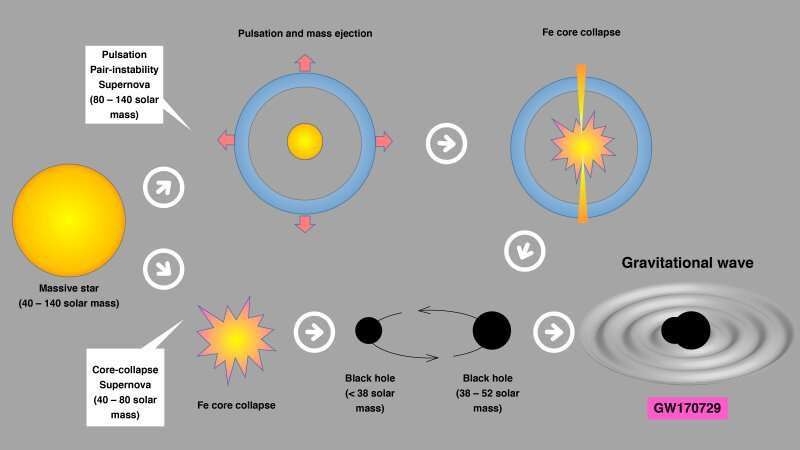
Through simulations of a dying star, a team of theoretical physics researchers have found the evolutionary origin and the maximum mass of black holes which are discovered by the detection of gravitational waves.
The exciting detection of gravitational waves with LIGO (laser interferometer gravitational-wave observatory) and VIRGO (Virgo interferometric gravitational-wave antenna) have shown the presence of merging black holes in close binary systems.
The masses of the observed black holes before merging have been measured and turned out to have a much larger than previously expected mass of about 10 times the mass of the Sun (solar mass). In one such event, GW170729, the observed mass of a black hole before merging is actually as large as about 50 solar masses. But it is not clear which stars can form such a massive black hole, or what the maximum size of black holes observed by the gravitational wave detectors is.
To answer this question, a research team at the Kavli Institute for the Physics and Mathematics of the Universe (Kavli IPMU) consisting of Project Researcher Shing-Chi Leung (currently at the California Institute of Technology), Senior Scientist Ken'ichi Nomoto, and Visiting Senior Scientist Sergei Blinnikov (professor at the Institute for Theoretical and Experimental Physics in Mosow) have investigated the final stage of the evolution of very massive stars, in particular 80 to 130 solar mass stars in close binary systems.


$1:
Schematic diagram of the binary black hole formation path for GW170729. A star below 80 solar masses evolves
Through simulations of a dying star, a team of theoretical physics researchers have found the evolutionary origin and the maximum mass of black holes which are discovered by the detection of gravitational waves.
The exciting detection of gravitational waves with LIGO (laser interferometer gravitational-wave observatory) and VIRGO (Virgo interferometric gravitational-wave antenna) have shown the presence of merging black holes in close binary systems.
The masses of the observed black holes before merging have been measured and turned out to have a much larger than previously expected mass of about 10 times the mass of the Sun (solar mass). In one such event, GW170729, the observed mass of a black hole before merging is actually as large as about 50 solar masses. But it is not clear which stars can form such a massive black hole, or what the maximum size of black holes observed by the gravitational wave detectors is.
To answer this question, a research team at the Kavli Institute for the Physics and Mathematics of the Universe (Kavli IPMU) consisting of Project Researcher Shing-Chi Leung (currently at the California Institute of Technology), Senior Scientist Ken'ichi Nomoto, and Visiting Senior Scientist Sergei Blinnikov (professor at the Institute for Theoretical and Experimental Physics in Mosow) have investigated the final stage of the evolution of very massive stars, in particular 80 to 130 solar mass stars in close binary systems.

https://phys.org/news/2020-07-maximum-m ... holes.html
Previous 1 ... 172 173 174 175 176 177 178 ... 237 Next